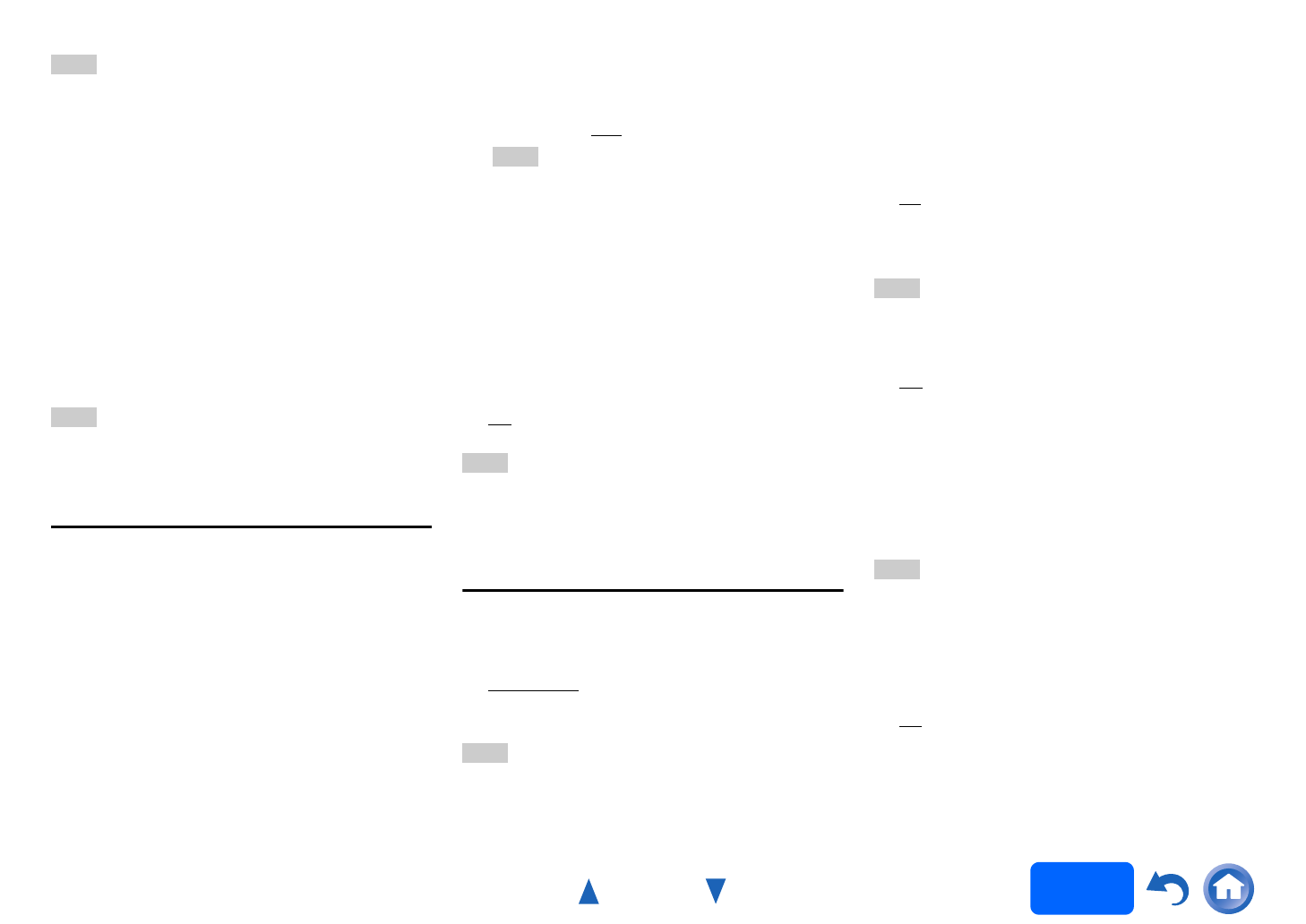
Advanced Operations
En-67
Operating
procedure
(➔ page 61)
Note
• These settings cannot be calibrated when the AV receiver
is muted.
• Speakers that you set to “No” or “None” in
“Speaker Configuration” cannot be selected (➔ page 65).
• When the “Powered Zone 3” setting is set to “Yes”
(➔ page 65) while Powered Zone 2 is enabled
(➔ page 84), the surround back speakers cannot be used.
• When the “Speakers Type(Front)” setting is set to
“Bi-Amp” or “Digital Crossover” while Powered Zone 2 is
enabled (➔ page 84), the surround back speakers cannot
be used.
• The test tone is output at the standard level for THX, which
is 0 dB (absolute volume setting 82). If you normally listen
at volume settings below this, be careful because the test
tone will be much louder.
*1
For the center speaker and subwoofer, the level settings
made by using the Quick Setup are saved in this menu
(➔ page 59).
Tip
•
If you’re using a handheld sound level meter, adjust the level
of each speaker so that it reads 75 dB SPL at the listening
position, measured with C-weighting and slow reading.
Equalizer Settings
With the Equalizer settings, you can adjust the tone of
speakers individually with a 7-band equalizer. The
volume of each speaker can be set.
■ Manual Equalizer
`On:
You can adjust the equalizer for each speaker
manually. Continue with the following procedure:
`Off
:
Tone off, response flat.
Note
• When the Direct or Pure Audio listening mode is selected,
the equalizer settings have no effect.
• If “Audyssey” is enabled, it prevails over this setting
(➔ page 71).
THX Audio Setup
■ Surr Back Speaker Spacing
`<1ft (<0.3m)
`1ft-4ft (0.3m-1.2m)
`>4ft (>1.2m)
You can specify the distance between your surround
back speakers.
Note
• Cannot be set if:
–“Surround Back” is set to “None” (➔ page 65).
–“Surround Back Ch” is set to “1ch” (➔ page 66).
–The “Powered Zone 3” setting is set to “Yes”
(➔ page 65) while Powered Zone 2 is enabled
(➔ page 84).
–The “Speakers Type(Front)” setting is set to “Bi-Amp” or
“Digital Crossover” while Powered Zone 2 is enabled
(➔ page 84).
■ THX Ultra2/Select2 Subwoofer
`No
`Yes
If you’re using a THX-certified subwoofer, set this
setting to “Yes”.
Note
• If the “Subwoofer” setting is set to “No”, this setting cannot
be selected (➔ page 65).
■ BGC
`Off
`On
If your listening room layout (for practical or aesthetic
reasons) locates most of the listeners close to the
rear wall, the resulting bass level can be sufficiently
reinforced by the boundary that the overall sound
becomes “boomy”. THX Select2 Plus receivers
contain a Boundary Gain Compensation (BGC)
feature to improve bass balance.
Note
• This setting is only available if “THX Ultra2/Select2
Subwoofer” is set to “Yes”.
• If the “Subwoofer” setting is set to “No”, this setting cannot
be selected (➔ page 65).
■ Loudness Plus
`Off
`On
When the “Loudness Plus” setting is set to “On”, it is
possible to enjoy even subtle nuances of audio
expression at low volume. This is only available when
the THX listening mode is selected.
1
Press to select “Channel”, and then use
/ to select a speaker.
2
Use / to select a frequency, and then use
the / to adjust the level at that frequency.
The volume at each frequency can be adjusted
from –6dB to 0dB
to +6dB in 1 dB steps.
Tip
• You can select: “63Hz”, “160Hz”, “400Hz”, “1kHz”,
“2.5kHz”, “6.3kHz”, or “16kHz”. And for the subwoofer,
“25Hz”, “40Hz”, “63Hz”, “100Hz”, or “160Hz”.
• Low frequencies (e.g., 63 Hz) affect bass sounds; high
frequencies (e.g., 16 kHz) affect treble sounds.
3
Use to select “Channel”, and then use /
to select another speaker.
Repeat steps 1 and 2 for each speaker.
You cannot select speakers that you set to “No”
or “None” in the “Speaker Configuration”
(➔ page 65).


















